May 26 Espanola
Overnight was supposed to be one of our roughest passages, but it actually went pretty smoothly (actually found out later that some people had a hard time and got sick; I slept like a log). Anchored in the morning the whole boat goes side to side as swells pass.

|
| Nursing sea lion
|
We chose to go on the long hike this morning. Carmen was our guide. The water is really pretty and as we approached the very rocky shore there were sea lions swimming all around us. Once we got on shore (some steps were built down to the water and a concrete pathway was made over the rocks) we saw many sea lions and tons of marine iguanas. The sea lions would just lie wherever and wouldn't move. One baby was feeding from its mother.
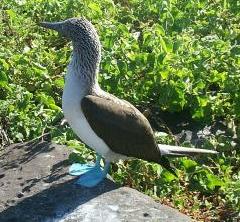
|
| Blue-footed booby
|
A sea lion cub swam and crawled up onto the steps where the pangas would land after we got on shore. It took a little while to make it move: you can clap and yell at the sea lion but they aren't afraid of you so they don't move. Part of the deal with not moving is there aren't any predators for large animals, but part is also that some of these animals are barely surviving and they can't afford to expend energy getting out of the way.
While Carmen was very informative it was hard to stand there and listen when there was so much to see. There were a lot more people on the island (a couple of other boats were anchored nearby) than I thought there would be. One of the guides said the Galapagos were the Disneyworld of Ecuador and today there were lines like Disneyworld.
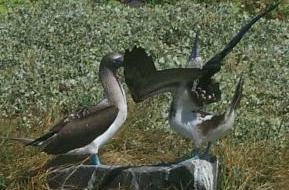
|
| Dancing booby
|

|
| Booby and guests
|
Within a hundred feet of the landing we saw a Galapagos hawk, a gray snake, lava lizards, Galapagos doves, finches, mockingbirds, yellow crowned night heron, blue-footed boobies, tropic bird, frigate birds, and an oystercatcher. The only things we really had to hike to were the nesting Albatrosses, the really pretty coastline and the nazca boobies.
We saw lots of blue-footed boobies today onshore and flying around. It is mating season and they are paired off and doing their dances. The females whistle and the males honk but it's more like a quack. A lot of whistling and quacking (hear it for yourself).
Saw some albatrosses lying on the ground. Sometimes they are sitting on their nests, sometimes not. We saw an abandoned egg next to the trail.
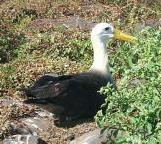
|
| Nesting waved albatross
|
The beach was very pretty and there were some big waves crashing in on the rocks. A blowhole would shoot spray 30-50 feet in the air. The spray could be seen from where the ship was anchored and some people thought it was a geyser.
One area with smaller pebbles (a couple of inches) is off-limits because it is one of the few places the iguanas can move the rocks and bury their eggs.
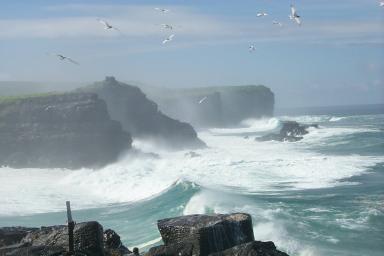
|
| Crashing waves
|
There are only 4 non-Audubon passengers on board for a total of 52. The crew numbers 59 so we are actually outnumbered. The boat can carry up to 80 passengers. Kind of surprising since this is a good time to come. We are between seasons so the weather is very nice but not too hot. And the water is pretty warm.

|
| Spotted eagle ray
|
In the afternoon we went snorkeling for the first time of the trip. After an information session we were fitted for wetsuits. The suits are one piece with short pants and short sleeves. But they're still very tight and take some getting used to. They keep you warm even in the cold water though. We went diving off an island and saw king angelfish, a spotted eagle ray, big starfish a couple of feet across and with thick arms, and pufferfish. Susan saw a long skinny coronet fish. While we were swimming a sea lion swam by me but quickly went on its way. Others saw a green sea turtle and a white-tipped shark.
Lindblad's Daily Expedition Report
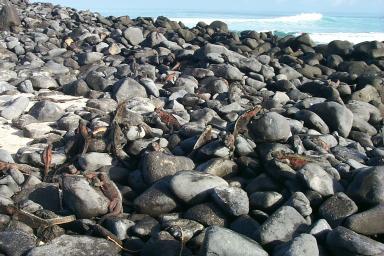
|
| Marine iguanas
|








